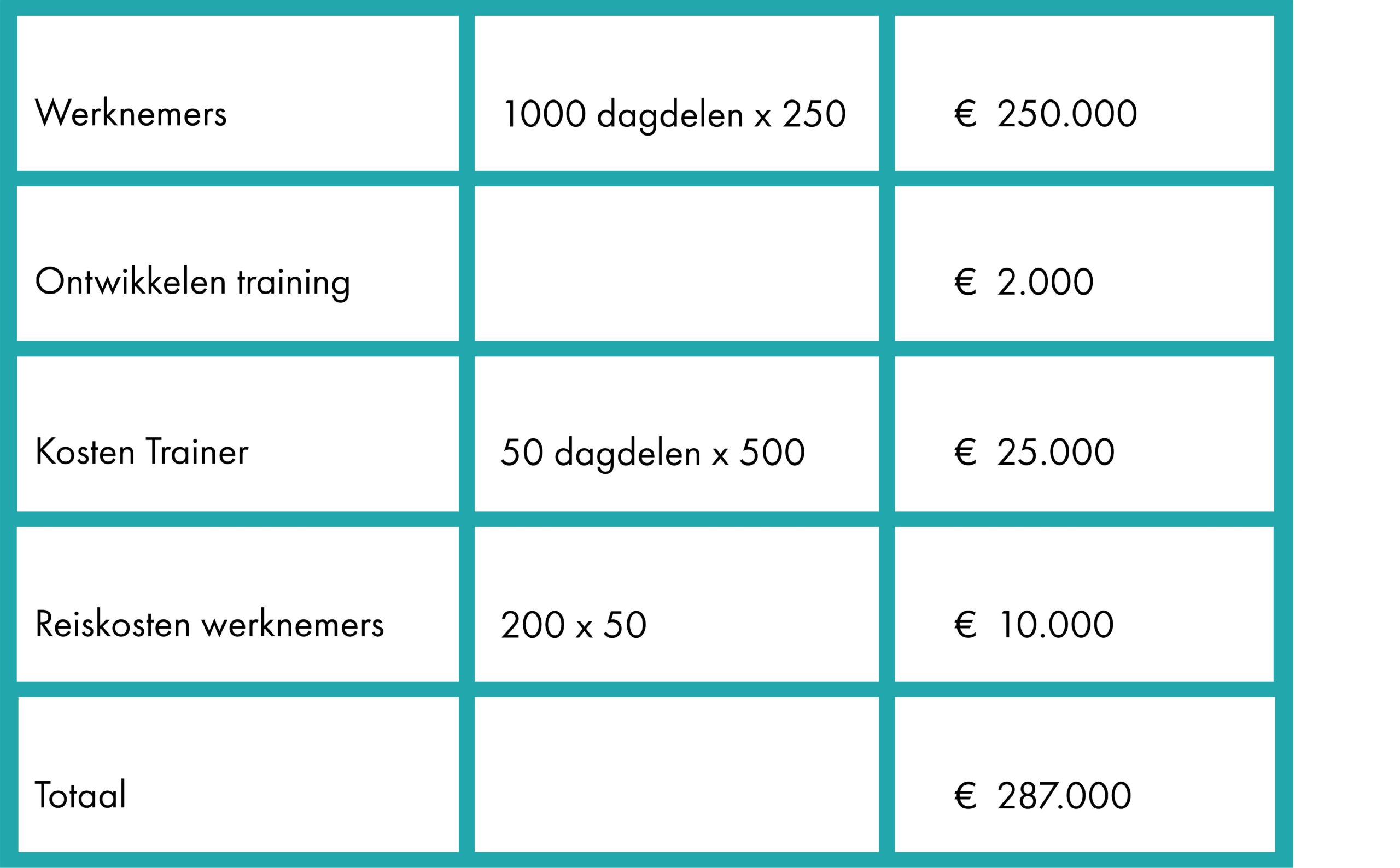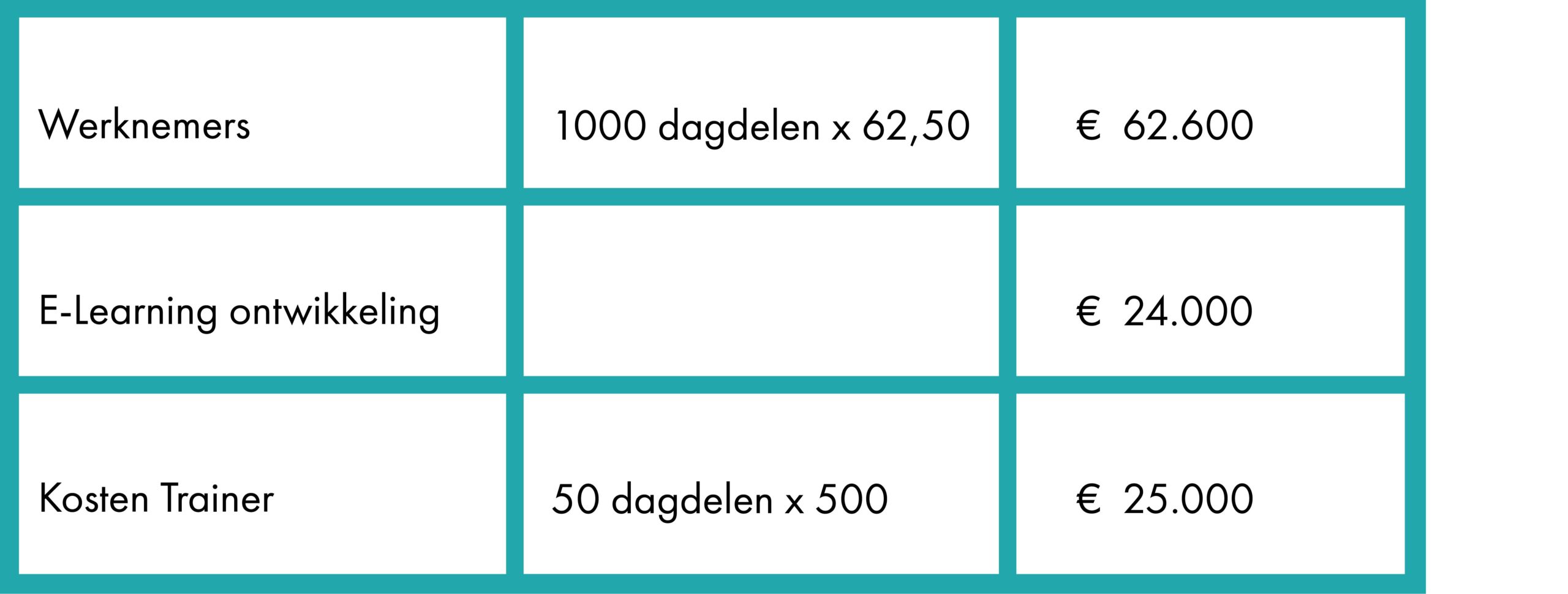ROI leeroplossing rekenvoorbeeld
Om de ROI (Return On Investment, rendement op investering) van een leeroplossing te berekenen moet je de situatie goed afbakenen. Wil je de ROI van e-learning afzetten tegenover klassikaal leren, heb je andere variabelen dan wanneer je wel-leren afzet tegen niet-leren. Vaak zal een tussenoplossing gebruikt worden, een blended-learning omgeving.
E-learning ten opzichte van klassikaal leren
Stel je hebt een organisatie van 1000 werknemers en iedereen moet getraind worden op Informatieveiligheid.
Klassikale training
Voorbeeld: Informatieveiligheid is een training van een halve dag en je kunt maximaal 20 mensen tegelijkertijd in een klas hebben. Je hebt dus 50 sessies nodig. Gelukkig beschik je over interne lokalen en eenvoudigheidshalve rekenen we daar niets voor.
Een trainer kost € 500 per dagdeel. Een werknemer kost gemiddeld € 250 per dagdeel ( € 62,50 per uur). Ongeveer 200 van de 1000 werknemers werken op een andere locatie en moeten reizen met gemiddelde reiskosten van € 50. Het ontwikkelen van de training zelf kost € 2000.

Klassikaal: € 287.000, ofwel € 287 per medewerker.
E-learning
Een halve dag klassikaal leren komt gemiddeld overeen met een uur e-learning. Het laten ontwikkelen van een e-learning module kan vrij duur zijn. Afhankelijk van de complexiteit, gebruikte media, de duur, enz. Gemiddeld kost het ongeveer 200 uur tijd (bron: ChapmanAlliance) om een e-learning van een uur te maken. Met een uurtarief van € 120 komt dit uit op € 24.000

E-Learning: € 86.600, ofwel € 86,60 per medewerker.
Zoals je kunt zien is dit een besparing van € 200.400. Heel aanzienlijk voor een enkele cursus! Naast deze financiële besparing is er ook een verschil in de efficiëntie van de twee methoden. Onderzoek heeft aangetoond dat e-learning een hogere retentie heeft dan klassikaal leren. Volgens de Gartner Group is de retentie van e-learning twee keer zo hoog als klassikaal leren. Naast het al berekende financiële voordeel is dit natuurlijk een enorm extra voordeel.

Wel of Niet Leren?
Dit is veel moeilijker. Hoe bereken je wat leren, ongeacht de methode, opbrengt? Soms is het gewoon de organisatie die bepaalt dat men iets geleerd moet hebben, ongeacht de kosten. Cursussen zoals informatieveiligheid, seksuele intimidatie op de werkplaats en dergelijke worden gewoon opgelegd door de organisatie. De ROI is dan niet in geld uit te drukken; het gaat om het met succes bereiken van een gevoelswaarde.
Andere soorten trainingen kunnen wel worden gebruikt in een ROI analyse. Een training als “Nieuwe werknemer”, zal hopelijk werknemers eerder productief maken. Een training als “Succesvol Verkopen” zal hopelijk de verkoopcijfers doen stijgen. En dat is in geld uit te drukken.
Je hebt daarvoor wel controlegroepen nodig. Dit kun je bijvoorbeeld doen door een aantal verkopers (de controlegroep) de “Succesvol Verkopen” training te laten volgen. Je weet wat hun verkoopprestaties waren voor de training. Na afloop van de training bekijk je of die prestaties zijn veranderd. Stel nu dat de prestaties 5% zijn gestegen. Dan kun je aannemen dat als je alle verkopers deze training laat volgens, dat dan de totale verkoop 5% zal stijgen.
Als je omzet 10 miljoen was, dan zal de verwachte omzet stijgen met € 500.000. Daar zet je de kosten van het ontwikkelen en leveren van de training tegenover en je hebt je ROI. Je kunt daarvoor dezelfde soort berekening gebruiken als in het eerste voorbeeld.


Recent Comments